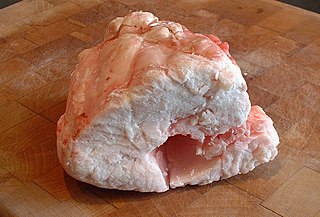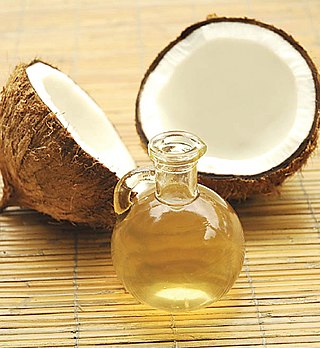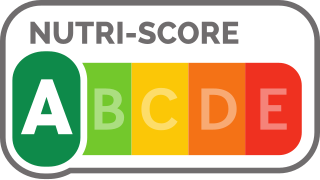The overall nutritional quality index was a nutritional rating system developed at the Yale-Griffin Prevention Research Center in 2008. A proprietary algorithm assigned foods a score between 1 and 100 intended to reflect the overall nutritional value a portion of the given food provided. [1] The system was marketed commercially as NuVal by NuVal, LLC, a joint venture with Topco Associates. [2] Over 1600 grocery stores in the United States placed NuVal scores on product shelf tags next to the price. [3] [2] The commercial product was discontinued in 2017 amid accusations of conflicts of interest and criticism of NuVal LLC's refusal to publish the algorithm. [4] Either of which may have contributed to some inconsistencies in scoring where certain processed foods scored higher than, for instance, canned fruits and vegetables. [4]
The algorithm considers thirty nutrient factors, like the relative portions of vitamins, sugar, saturated fat, and trans fats and the quality of the protein and fat, [5] and produces a score from one to 100. Higher scores represent greater overall nutritional value. However, the actual algorithm, including the relative weights of the nutrients, was never disclosed to the public. [4]
Broccoli, blueberries, okra, oranges, and green beans were some foods that received the best score (100) while ice pops and soft drinks received the worst (1). [1]

In nutrition, biology, and chemistry, fat usually means any ester of fatty acids, or a mixture of such compounds, most commonly those that occur in living beings or in food.

Nutrition is the biochemical and physiological process by which an organism uses food to support its life. It provides organisms with nutrients, which can be metabolized to create energy and chemical structures. Failure to obtain the required amount of nutrients causes malnutrition. Nutritional science is the study of nutrition, though it typically emphasizes human nutrition.

"Junk food" is a term used to describe food that is high in calories from macronutrients such as sugar and/or fat, and possibly sodium, making it hyperpalatable, but with insufficient dietary fiber, protein, or micronutrients such as vitamins and minerals. It is also known as HFSS food. The term junk food is a pejorative dating back to the 1950s. Many variations of junk food can be easily found in most supermarkets and fast food restaurants. Due to easy accessibility, commercially-oriented packaging, and often-low prices, people are most likely to consume it.

Suet is the raw, hard fat of beef, lamb or mutton found around the loins and kidneys.

Coconut oil is an edible oil derived from the kernels, meat, and milk of the coconut palm fruit. Coconut oil is a white solid fat below around 25 °C (77 °F), and a clear thin liquid oil in warmer climates. Unrefined varieties have a distinct coconut aroma. Coconut oil is used as a food oil, and in industrial applications for cosmetics and detergent production. The oil is rich in medium-chain fatty acids.
A saturated fat is a type of fat in which the fatty acid chains have all single bonds between the carbon atoms. A fat known as a glyceride is made of two kinds of smaller molecules: a short glycerol backbone and fatty acids that each contain a long linear or branched chain of carbon (C) atoms. Along the chain, some carbon atoms are linked by single bonds (-C-C-) and others are linked by double bonds (-C=C-). A double bond along the carbon chain can react with a pair of hydrogen atoms to change into a single -C-C- bond, with each H atom now bonded to one of the two C atoms. Glyceride fats without any carbon chain double bonds are called saturated because they are "saturated with" hydrogen atoms, having no double bonds available to react with more hydrogen.

The Weston A. Price Foundation (WAPF), co-founded in 1999 by Sally Fallon (Morell) and nutritionist Mary G. Enig, is a U.S. 501(c)(3) nonprofit organization dedicated to "restoring nutrient-dense foods to the American diet through education, research and activism".

Oleic acid is a fatty acid that occurs naturally in various animal and vegetable fats and oils. It is an odorless, colorless oil, although commercial samples may be yellowish due to the presence of impurities. In chemical terms, oleic acid is classified as a monounsaturated omega-9 fatty acid, abbreviated with a lipid number of 18:1 cis-9, and a main product of Δ9-desaturase. It has the formula CH3−(CH2)7−CH=CH−(CH2)7−COOH. The name derives from the Latin word oleum, which means oil. It is the most common fatty acid in nature. The salts and esters of oleic acid are called oleates. It is a common component of oils, and thus occurs in many types of food, as well as in soap.

Omega-6 fatty acids are a family of polyunsaturated fatty acids that have in common a final carbon-carbon double bond in the n-6 position, that is, the sixth bond, counting from the methyl end.

Cat food is food specifically formulated and designed for consumption by cats. As obligate carnivores, cats have specific requirements for their dietary nutrients, namely nutrients found only in meat or synthesised, such as taurine and Vitamin A. Certain nutrients, including many vitamins and amino acids, are degraded by the temperatures, pressures and chemical treatments used during manufacture, and hence must be added after manufacture to avoid nutritional deficiency. Cat food is typically sold as dry kibble, or as wet food in cans and pouches.

Peanut oil, also known as groundnut oil or arachis oil, is a vegetable oil derived from peanuts. The oil usually has a mild or neutral flavor but, if made with roasted peanuts, has a stronger peanut flavor and aroma. It is often used in American, Chinese, Indian, African and Southeast Asian cuisine, both for general cooking and in the case of roasted oil, for added flavor. Peanut oil has a high smoke point relative to many other cooking oils, so it is commonly used for frying foods.

A healthy diet is a diet that maintains or improves overall health. A healthy diet provides the body with essential nutrition: fluid, macronutrients such as protein, micronutrients such as vitamins, and adequate fibre and food energy.

The nutrition facts label is a label required on most packaged food in many countries, showing what nutrients and other ingredients are in the food. Labels are usually based on official nutritional rating systems. Most countries also release overall nutrition guides for general educational purposes. In some cases, the guides are based on different dietary targets for various nutrients than the labels on specific foods.
Nutritional rating systems are used to communicate the nutritional value of food in a more-simplified manner, with a ranking, than nutrition facts labels. A system may be targeted at a specific audience. Rating systems have been developed by governments, non-profit organizations, private institutions, and companies. Common methods include point systems to rank foods based on general nutritional value or ratings for specific food attributes, such as cholesterol content. Graphics and symbols may be used to communicate the nutritional values to the target audience.
Nutritional value or nutritive value as part of food quality is the measure of a well-balanced ratio of the essential nutrients carbohydrates, fat, protein, minerals, and vitamins in items of food or diet concerning the nutrient requirements of their consumer. Several nutritional rating systems and nutrition facts label have been implemented to rank food in terms of its nutritional value. International and national guidelines exist to inform consumers about optimal nutrient intake from their diets.

Fat, Sick and Nearly Dead is a 2010 American documentary film which follows the 60-day journey of Australian Joe Cross across the United States as he follows a juice fast to regain his health under the care of Joel Fuhrman, Nutrition Research Foundation's Director of Research.

David L. Katz is an American physician, nutritionist and writer. He was the founding director of the Yale-Griffin Prevention Research Center that was founded at Griffin Hospital in 1998. Katz is the founder of True Health Initiative and is an advocate of plant-predominant diets.

Preventive Nutrition is a branch of nutrition science with the goal of preventing, delaying, and/or reducing the impacts of disease and disease-related complications. It is concerned with a high level of personal well-being, disease prevention, and diagnosis of recurring health problems or symptoms of discomfort which are often precursors to health issues. The overweight and obese population numbers have increased over the last 40 years and numerous chronic diseases are associated with obesity. Preventive nutrition may assist in prolonging the onset of non-communicable diseases and may allow adults to experience more "healthy living years." There are various ways of educating the public about preventive nutrition. Information regarding preventive nutrition is often communicated through public health forums, government programs and policies, or nutritional education. For example, in the United States, preventive nutrition is taught to the public through the use of the food pyramid or MyPlate initiatives.

The Nutri-Score, also known as the 5-Colour Nutrition label or 5-CNL, is a five-colour nutrition label and nutritional rating system, and an attempt to simplify the nutritional rating system demonstrating the overall nutritional value of food products. It assigns products a rating letter from A (best) to E (worst), with associated colors from green to red.

The Health Star Rating System (HSR) is an Australian and New Zealand Government initiative that assigns health ratings to packaged foods and beverages. The purpose for the Health Star Rating is to provide a visual comparison of like for like products, to assist consumers into distinguishing and choosing the healthier options. It was designed to target time-deprived working adults as well as parents and children who were less likely to check how healthy each individual product was, through examination of the nutritional facts label on the back of products.